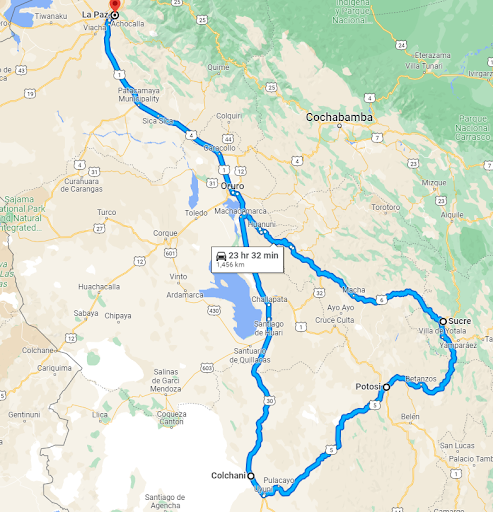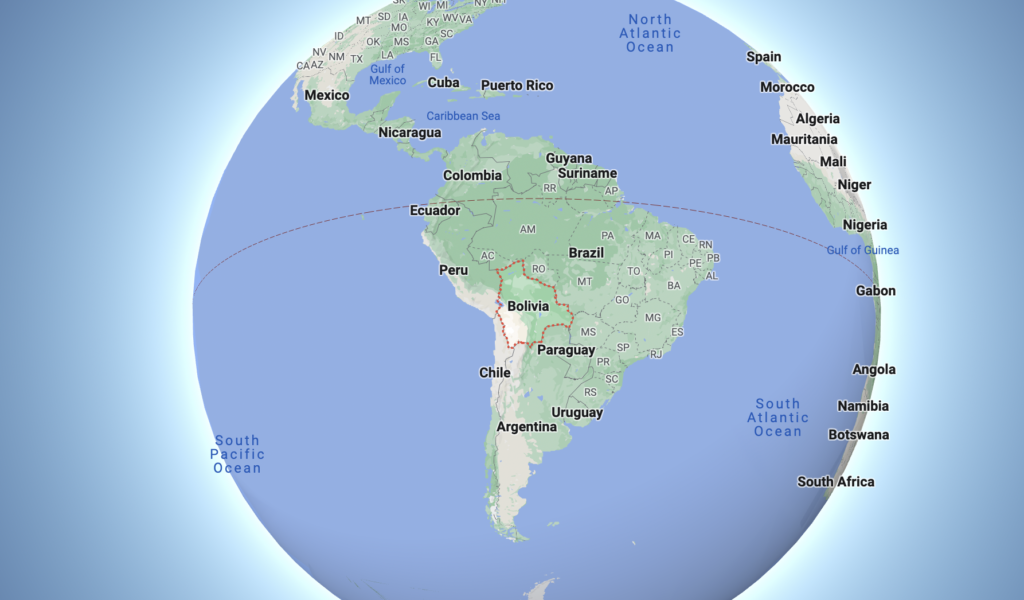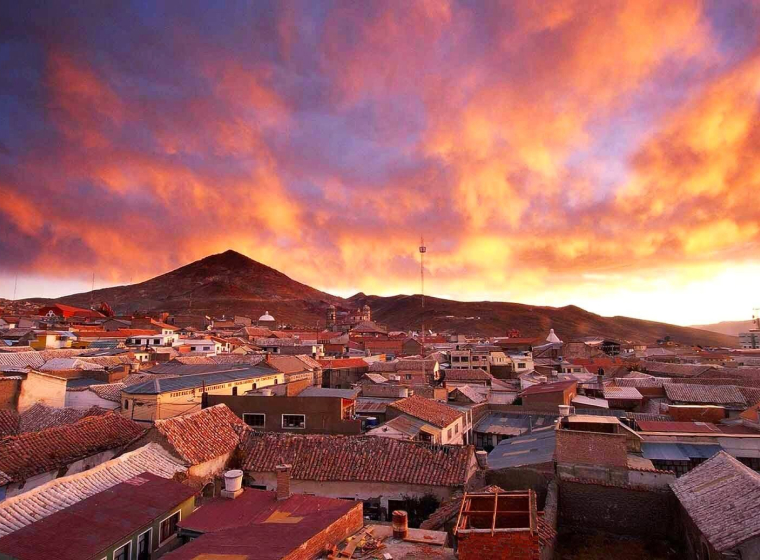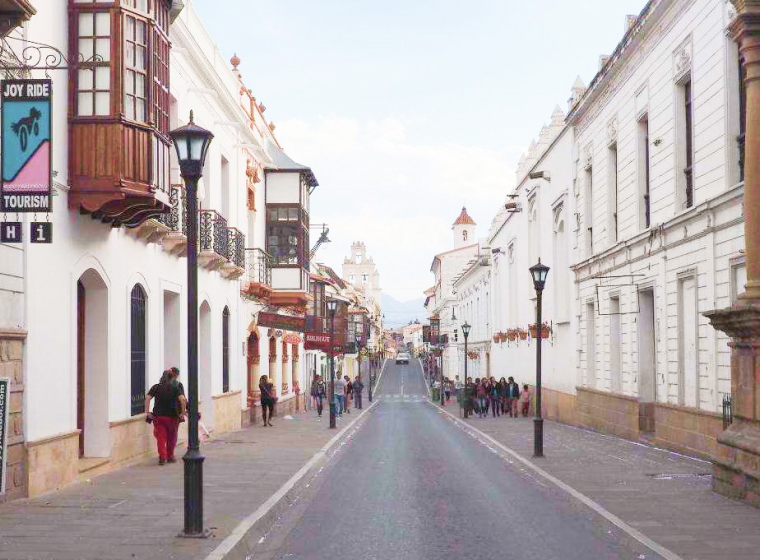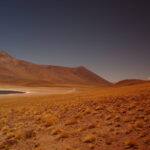Highlights of Bolivia
7 Days
South America
Tour Overview
- Enjoy the spectacular setting of La Paz.
- Discover the Salar de Uyuni, the largest salt desert in the world. An incredible place that seems to be taken from another planet.
- Roundtrip Airport
- Transfers throughout the program.
- Transfers to the excursions.
- 6nts Accommodation including Breakfast.
- Excursions as outlined in the program.
- Private transport from Hito Cajon to Uyuni.
- Catamaran sailing in La Paz.
- Meals s per the itinerary.
- Permanent assistance in each destination.
- Raincoats and boots in Uyuni in rainy season.
- International or domestic airfare.
- Services and non-mentioned meals / drinks in the itinerary.
- Early check-in, late check-out, and hotel extra
- Personal expenses.
- Tips for guides and hotel staff.
Private transfer from the airport and visit to the city of La Paz.
The city of contrasts, both topographically and culturally. Topographically, La Paz has an impressive environment, and the views are amazing. It lies at the bottom of a huge canyon with the snow-covered, three-peaked Illimani Mountain providing a dramatic backdrop. It belongs to the same scenic league as Rio de Janeiro, Cape Town, San Francisco, and Hong Kong. The multicultural and multiethnic contrast is also fascinating. In no other capital city in Latin America are there such differences between its inhabitants; from indigenous women wearing traditional hats and voluminous skirts, selling Andean crops on the pavements, to businessmen rushing to modern office buildings.
La Paz also has an important colonial scene; Calle Colonial Jaen is one of the city’s best-preserved colonial streets. In the centre of the colonial city is the Plaza Murillo, home to the Presidential Palace, the Parliament building and the Cathedral. A good number of colonial buildings still survive in the surroundings of this square. Also, in the colonial centre of the city we can find the Witches’ Market. This market provides a fascinating window on the generally secret world of Aymara mysticism and herbal medicine. The stalls here are loaded with a colourful cornucopia of rituals and medicinal items, ranging from herbal medicines for minor ailments such as rheumatism or stomach pain to incense, coloured sweets, protective talismans, and dried llama foetuses. These items are combined in packages known as tables or “payoffs” and are burned or buried as offerings to appease the various guardian spirits and magical beings believed to dominate all aspects of daily life. There is no clear boundary between the medicinal and the magical.
The Rodriguez Market is the most authentic and popular food market in the city of La Paz. The market is packed with stalls selling fresh vegetables, fruit, meat, and fish, and at the same time, customers and vendors negotiate for a convenient price. At this market you can experience a range of aromas, colours, and flavours. One of the most incredible things to do in Bolivia is, without a doubt, to travel in a La Paz Cable Car. This is the first cable car in the world to be used as a primary transport network instead of subways or trains. La Paz is situated in a deep valley, the topography of the whole city is steep and full of hills, the city itself in a crowded and chaotic area; so, flying over the city in a cabin of eight people with panoramic and spectacular views of the shining city, is something fascinating.
The Valley of the Moon, which is situated 10 kilometres from the centre of La Paz, is a unique area with lunar landscapes. High, toasted pinnacles rise from the eroded hillside, creating a maze of otherworldly geological formations. These clay and sandstone figures took shape over thousands of years as strong winds and rains eroded the mountains resulting in a strange and fascinating landscape to behold.
Overnight in La Paz
Private transfer from the airport and visit to the city of La Paz.
The city of contrasts, both topographically and culturally. Topographically, La Paz has an impressive environment, and the views are amazing. It lies at the bottom of a huge canyon with the snow-covered, three-peaked Illimani Mountain providing a dramatic backdrop. It belongs to the same scenic league as Rio de Janeiro, Cape Town, San Francisco, and Hong Kong. The multicultural and multiethnic contrast is also fascinating. In no other capital city in Latin America are there such differences between its inhabitants; from indigenous women wearing traditional hats and voluminous skirts, selling Andean crops on the pavements, to businessmen rushing to modern office buildings.
La Paz also has an important colonial scene; Calle Colonial Jaen is one of the city’s best-preserved colonial streets. In the centre of the colonial city is the Plaza Murillo, home to the Presidential Palace, the Parliament building and the Cathedral. A good number of colonial buildings still survive in the surroundings of this square. Also, in the colonial centre of the city we can find the Witches’ Market. This market provides a fascinating window on the generally secret world of Aymara mysticism and herbal medicine. The stalls here are loaded with a colourful cornucopia of rituals and medicinal items, ranging from herbal medicines for minor ailments such as rheumatism or stomach pain to incense, coloured sweets, protective talismans, and dried llama foetuses. These items are combined in packages known as tables or “payoffs” and are burned or buried as offerings to appease the various guardian spirits and magical beings believed to dominate all aspects of daily life. There is no clear boundary between the medicinal and the magical.
The Rodriguez Market is the most authentic and popular food market in the city of La Paz. The market is packed with stalls selling fresh vegetables, fruit, meat, and fish, and at the same time, customers and vendors negotiate for a convenient price. At this market you can experience a range of aromas, colours, and flavours. One of the most incredible things to do in Bolivia is, without a doubt, to travel in a La Paz Cable Car. This is the first cable car in the world to be used as a primary transport network instead of subways or trains. La Paz is situated in a deep valley, the topography of the whole city is steep and full of hills, the city itself in a crowded and chaotic area; so, flying over the city in a cabin of eight people with panoramic and spectacular views of the shining city, is something fascinating.
The Valley of the Moon, which is situated 10 kilometres from the centre of La Paz, is a unique area with lunar landscapes. High, toasted pinnacles rise from the eroded hillside, creating a maze of otherworldly geological formations. These clay and sandstone figures took shape over thousands of years as strong winds and rains eroded the mountains resulting in a strange and fascinating landscape to behold.
Overnight in La Paz
Private transfer from the airport and visit to the city of La Paz.
The city of contrasts, both topographically and culturally. Topographically, La Paz has an impressive environment, and the views are amazing. It lies at the bottom of a huge canyon with the snow-covered, three-peaked Illimani Mountain providing a dramatic backdrop. It belongs to the same scenic league as Rio de Janeiro, Cape Town, San Francisco, and Hong Kong. The multicultural and multiethnic contrast is also fascinating. In no other capital city in Latin America are there such differences between its inhabitants; from indigenous women wearing traditional hats and voluminous skirts, selling Andean crops on the pavements, to businessmen rushing to modern office buildings.
La Paz also has an important colonial scene; Calle Colonial Jaen is one of the city’s best-preserved colonial streets. In the centre of the colonial city is the Plaza Murillo, home to the Presidential Palace, the Parliament building and the Cathedral. A good number of colonial buildings still survive in the surroundings of this square. Also, in the colonial centre of the city we can find the Witches’ Market. This market provides a fascinating window on the generally secret world of Aymara mysticism and herbal medicine. The stalls here are loaded with a colourful cornucopia of rituals and medicinal items, ranging from herbal medicines for minor ailments such as rheumatism or stomach pain to incense, coloured sweets, protective talismans, and dried llama foetuses. These items are combined in packages known as tables or “payoffs” and are burned or buried as offerings to appease the various guardian spirits and magical beings believed to dominate all aspects of daily life. There is no clear boundary between the medicinal and the magical.
The Rodriguez Market is the most authentic and popular food market in the city of La Paz. The market is packed with stalls selling fresh vegetables, fruit, meat, and fish, and at the same time, customers and vendors negotiate for a convenient price. At this market you can experience a range of aromas, colours, and flavours. One of the most incredible things to do in Bolivia is, without a doubt, to travel in a La Paz Cable Car. This is the first cable car in the world to be used as a primary transport network instead of subways or trains. La Paz is situated in a deep valley, the topography of the whole city is steep and full of hills, the city itself in a crowded and chaotic area; so, flying over the city in a cabin of eight people with panoramic and spectacular views of the shining city, is something fascinating.
The Valley of the Moon, which is situated 10 kilometres from the centre of La Paz, is a unique area with lunar landscapes. High, toasted pinnacles rise from the eroded hillside, creating a maze of otherworldly geological formations. These clay and sandstone figures took shape over thousands of years as strong winds and rains eroded the mountains resulting in a strange and fascinating landscape to behold.
Overnight in La Paz
Private transfer from the airport and visit to the city of La Paz.
The city of contrasts, both topographically and culturally. Topographically, La Paz has an impressive environment, and the views are amazing. It lies at the bottom of a huge canyon with the snow-covered, three-peaked Illimani Mountain providing a dramatic backdrop. It belongs to the same scenic league as Rio de Janeiro, Cape Town, San Francisco, and Hong Kong. The multicultural and multiethnic contrast is also fascinating. In no other capital city in Latin America are there such differences between its inhabitants; from indigenous women wearing traditional hats and voluminous skirts, selling Andean crops on the pavements, to businessmen rushing to modern office buildings.
La Paz also has an important colonial scene; Calle Colonial Jaen is one of the city’s best-preserved colonial streets. In the centre of the colonial city is the Plaza Murillo, home to the Presidential Palace, the Parliament building and the Cathedral. A good number of colonial buildings still survive in the surroundings of this square. Also, in the colonial centre of the city we can find the Witches’ Market. This market provides a fascinating window on the generally secret world of Aymara mysticism and herbal medicine. The stalls here are loaded with a colourful cornucopia of rituals and medicinal items, ranging from herbal medicines for minor ailments such as rheumatism or stomach pain to incense, coloured sweets, protective talismans, and dried llama foetuses. These items are combined in packages known as tables or “payoffs” and are burned or buried as offerings to appease the various guardian spirits and magical beings believed to dominate all aspects of daily life. There is no clear boundary between the medicinal and the magical.
The Rodriguez Market is the most authentic and popular food market in the city of La Paz. The market is packed with stalls selling fresh vegetables, fruit, meat, and fish, and at the same time, customers and vendors negotiate for a convenient price. At this market you can experience a range of aromas, colours, and flavours. One of the most incredible things to do in Bolivia is, without a doubt, to travel in a La Paz Cable Car. This is the first cable car in the world to be used as a primary transport network instead of subways or trains. La Paz is situated in a deep valley, the topography of the whole city is steep and full of hills, the city itself in a crowded and chaotic area; so, flying over the city in a cabin of eight people with panoramic and spectacular views of the shining city, is something fascinating.
The Valley of the Moon, which is situated 10 kilometres from the centre of La Paz, is a unique area with lunar landscapes. High, toasted pinnacles rise from the eroded hillside, creating a maze of otherworldly geological formations. These clay and sandstone figures took shape over thousands of years as strong winds and rains eroded the mountains resulting in a strange and fascinating landscape to behold.
Overnight in La Paz
Private transfer from the airport and visit to the city of La Paz.
The city of contrasts, both topographically and culturally. Topographically, La Paz has an impressive environment, and the views are amazing. It lies at the bottom of a huge canyon with the snow-covered, three-peaked Illimani Mountain providing a dramatic backdrop. It belongs to the same scenic league as Rio de Janeiro, Cape Town, San Francisco, and Hong Kong. The multicultural and multiethnic contrast is also fascinating. In no other capital city in Latin America are there such differences between its inhabitants; from indigenous women wearing traditional hats and voluminous skirts, selling Andean crops on the pavements, to businessmen rushing to modern office buildings.
La Paz also has an important colonial scene; Calle Colonial Jaen is one of the city’s best-preserved colonial streets. In the centre of the colonial city is the Plaza Murillo, home to the Presidential Palace, the Parliament building and the Cathedral. A good number of colonial buildings still survive in the surroundings of this square. Also, in the colonial centre of the city we can find the Witches’ Market. This market provides a fascinating window on the generally secret world of Aymara mysticism and herbal medicine. The stalls here are loaded with a colourful cornucopia of rituals and medicinal items, ranging from herbal medicines for minor ailments such as rheumatism or stomach pain to incense, coloured sweets, protective talismans, and dried llama foetuses. These items are combined in packages known as tables or “payoffs” and are burned or buried as offerings to appease the various guardian spirits and magical beings believed to dominate all aspects of daily life. There is no clear boundary between the medicinal and the magical.
The Rodriguez Market is the most authentic and popular food market in the city of La Paz. The market is packed with stalls selling fresh vegetables, fruit, meat, and fish, and at the same time, customers and vendors negotiate for a convenient price. At this market you can experience a range of aromas, colours, and flavours. One of the most incredible things to do in Bolivia is, without a doubt, to travel in a La Paz Cable Car. This is the first cable car in the world to be used as a primary transport network instead of subways or trains. La Paz is situated in a deep valley, the topography of the whole city is steep and full of hills, the city itself in a crowded and chaotic area; so, flying over the city in a cabin of eight people with panoramic and spectacular views of the shining city, is something fascinating.
The Valley of the Moon, which is situated 10 kilometres from the centre of La Paz, is a unique area with lunar landscapes. High, toasted pinnacles rise from the eroded hillside, creating a maze of otherworldly geological formations. These clay and sandstone figures took shape over thousands of years as strong winds and rains eroded the mountains resulting in a strange and fascinating landscape to behold.
Overnight in La Paz
Private transfer from the airport and visit to the city of La Paz.
The city of contrasts, both topographically and culturally. Topographically, La Paz has an impressive environment, and the views are amazing. It lies at the bottom of a huge canyon with the snow-covered, three-peaked Illimani Mountain providing a dramatic backdrop. It belongs to the same scenic league as Rio de Janeiro, Cape Town, San Francisco, and Hong Kong. The multicultural and multiethnic contrast is also fascinating. In no other capital city in Latin America are there such differences between its inhabitants; from indigenous women wearing traditional hats and voluminous skirts, selling Andean crops on the pavements, to businessmen rushing to modern office buildings.
La Paz also has an important colonial scene; Calle Colonial Jaen is one of the city’s best-preserved colonial streets. In the centre of the colonial city is the Plaza Murillo, home to the Presidential Palace, the Parliament building and the Cathedral. A good number of colonial buildings still survive in the surroundings of this square. Also, in the colonial centre of the city we can find the Witches’ Market. This market provides a fascinating window on the generally secret world of Aymara mysticism and herbal medicine. The stalls here are loaded with a colourful cornucopia of rituals and medicinal items, ranging from herbal medicines for minor ailments such as rheumatism or stomach pain to incense, coloured sweets, protective talismans, and dried llama foetuses. These items are combined in packages known as tables or “payoffs” and are burned or buried as offerings to appease the various guardian spirits and magical beings believed to dominate all aspects of daily life. There is no clear boundary between the medicinal and the magical.
The Rodriguez Market is the most authentic and popular food market in the city of La Paz. The market is packed with stalls selling fresh vegetables, fruit, meat, and fish, and at the same time, customers and vendors negotiate for a convenient price. At this market you can experience a range of aromas, colours, and flavours. One of the most incredible things to do in Bolivia is, without a doubt, to travel in a La Paz Cable Car. This is the first cable car in the world to be used as a primary transport network instead of subways or trains. La Paz is situated in a deep valley, the topography of the whole city is steep and full of hills, the city itself in a crowded and chaotic area; so, flying over the city in a cabin of eight people with panoramic and spectacular views of the shining city, is something fascinating.
The Valley of the Moon, which is situated 10 kilometres from the centre of La Paz, is a unique area with lunar landscapes. High, toasted pinnacles rise from the eroded hillside, creating a maze of otherworldly geological formations. These clay and sandstone figures took shape over thousands of years as strong winds and rains eroded the mountains resulting in a strange and fascinating landscape to behold.
Overnight in La Paz
Private transfer from the airport and visit to the city of La Paz.
The city of contrasts, both topographically and culturally. Topographically, La Paz has an impressive environment, and the views are amazing. It lies at the bottom of a huge canyon with the snow-covered, three-peaked Illimani Mountain providing a dramatic backdrop. It belongs to the same scenic league as Rio de Janeiro, Cape Town, San Francisco, and Hong Kong. The multicultural and multiethnic contrast is also fascinating. In no other capital city in Latin America are there such differences between its inhabitants; from indigenous women wearing traditional hats and voluminous skirts, selling Andean crops on the pavements, to businessmen rushing to modern office buildings.
La Paz also has an important colonial scene; Calle Colonial Jaen is one of the city’s best-preserved colonial streets. In the centre of the colonial city is the Plaza Murillo, home to the Presidential Palace, the Parliament building and the Cathedral. A good number of colonial buildings still survive in the surroundings of this square. Also, in the colonial centre of the city we can find the Witches’ Market. This market provides a fascinating window on the generally secret world of Aymara mysticism and herbal medicine. The stalls here are loaded with a colourful cornucopia of rituals and medicinal items, ranging from herbal medicines for minor ailments such as rheumatism or stomach pain to incense, coloured sweets, protective talismans, and dried llama foetuses. These items are combined in packages known as tables or “payoffs” and are burned or buried as offerings to appease the various guardian spirits and magical beings believed to dominate all aspects of daily life. There is no clear boundary between the medicinal and the magical.
The Rodriguez Market is the most authentic and popular food market in the city of La Paz. The market is packed with stalls selling fresh vegetables, fruit, meat, and fish, and at the same time, customers and vendors negotiate for a convenient price. At this market you can experience a range of aromas, colours, and flavours. One of the most incredible things to do in Bolivia is, without a doubt, to travel in a La Paz Cable Car. This is the first cable car in the world to be used as a primary transport network instead of subways or trains. La Paz is situated in a deep valley, the topography of the whole city is steep and full of hills, the city itself in a crowded and chaotic area; so, flying over the city in a cabin of eight people with panoramic and spectacular views of the shining city, is something fascinating.
The Valley of the Moon, which is situated 10 kilometres from the centre of La Paz, is a unique area with lunar landscapes. High, toasted pinnacles rise from the eroded hillside, creating a maze of otherworldly geological formations. These clay and sandstone figures took shape over thousands of years as strong winds and rains eroded the mountains resulting in a strange and fascinating landscape to behold.
Overnight in La Paz
